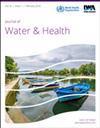Effects of the nutrient inhibition on the yield of DBPFPs by Microcystis aeruginosa
IF 2.5
4区 环境科学与生态学
Q3 ENVIRONMENTAL SCIENCES
引用次数: 0
Abstract
Abstract The yield of three disinfection byproduct formation potentials (DBPFPs), including trichloromethane, dichloroacetic acid and trichloroacetic acid formation potential (TCMFP, DCAAFP and TCAAFP), by Microcystis aeruginosa under the nitrate and phosphate inhibition conditions was investigated. The results showed that excessive nitrate could inhibit the growth of M. aeruginosa, but the concentration of DBPFPs in the five fractions of algal metabolites, including hydrophilic extracellular organic matter (EOM), hydrophobic EOM, hydrophilic intracellular organic matter, hydrophobic intracellular organic matter and cell debris, only decreased slightly. Accordingly, the productivity of DBPFPs by M. aeruginosa increased by approximately 40% under the nitrate inhibition condition and the increased productivity of DBPFPs mainly came from EOM. The phosphate inhibition also performed a similar pattern with a lesser extent. The nutrient inhibition did not change the proportion of these three DPBFPs, and TCMFP accounted for approximately 87% of the total DBPFPs. The inhibition could promote M. aeruginosa to secrete more metabolites. However, the cyanobacteria tended to secrete more DBPFPs under the nitrate inhibition condition, which resulted in an increased specific DBPFP, while they tended to secrete more non-DBPFPs under the phosphate inhibition condition, which resulted in a decreased specific DBPFP.营养抑制对铜绿微囊藻产DBPFPs的影响
摘要研究了铜绿微囊藻在硝酸盐和磷酸盐抑制条件下对三氯甲烷、二氯乙酸和三氯乙酸生成势(TCMFP、DCAAFP和TCAAFP)三种消毒副产物生成势(DBPFPs)的产率。结果表明,过量的硝酸盐可以抑制M. aeruginosa的生长,但在亲水性胞外有机物(EOM)、疏水性EOM、亲水性胞内有机物、疏水性胞内有机物和细胞碎片等藻类代谢产物的5个组分中,DBPFPs的浓度仅略有下降。因此,在硝酸盐抑制条件下,M. aeruginosa的DBPFPs产量增加了约40%,DBPFPs产量的增加主要来自EOM。磷酸盐抑制也表现出类似的模式,但程度较轻。营养抑制没有改变这三种dppfps的比例,TCMFP约占总DBPFPs的87%。抑制能促进M. aeruginosa分泌更多代谢物。然而,在硝酸盐抑制条件下,蓝藻倾向于分泌更多的DBPFPs,导致特异性DBPFP增加,而在磷酸盐抑制条件下,蓝藻倾向于分泌更多的非DBPFPs,导致特异性DBPFP降低。
本文章由计算机程序翻译,如有差异,请以英文原文为准。
求助全文
约1分钟内获得全文
求助全文
来源期刊

Journal of water and health
环境科学-环境科学
CiteScore
3.60
自引率
8.70%
发文量
110
审稿时长
18-36 weeks
期刊介绍:
Journal of Water and Health is a peer-reviewed journal devoted to the dissemination of information on the health implications and control of waterborne microorganisms and chemical substances in the broadest sense for developing and developed countries worldwide. This is to include microbial toxins, chemical quality and the aesthetic qualities of water.
 求助内容:
求助内容: 应助结果提醒方式:
应助结果提醒方式:


